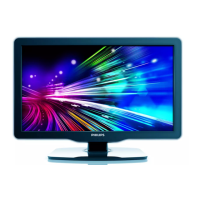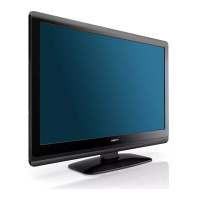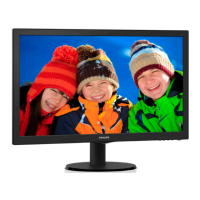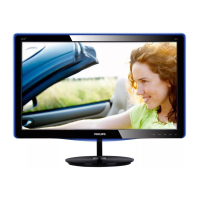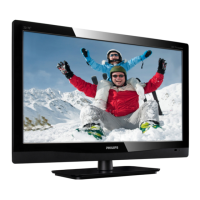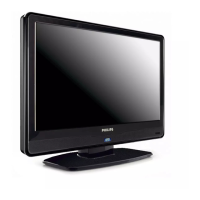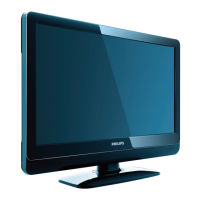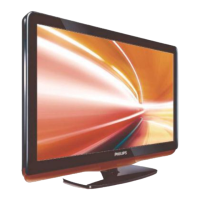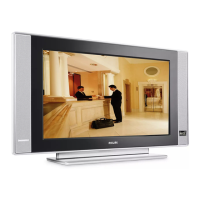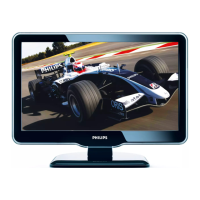
Do you have a question about the Philips 22PFL5604D/12 and is the answer not in the manual?
| Screen Size | 22 inches |
|---|---|
| Resolution | 1366 x 768 pixels |
| Display Type | LCD |
| Aspect Ratio | 16:9 |
| Brightness | 300 cd/m² |
| Contrast Ratio | 1000:1 |
| Response Time | 5 ms |
| HDMI Ports | 2 |
| USB Ports | 1 |
| Dynamic contrast ratio marketing name | Dynamic Contrast |
| Viewing angle, horizontal | 176 degrees |
| Viewing angle, vertical | 176 degrees |
| Comb filter | 3D |
| Component video (YPbPr/YCbCr) in | 1 |
| SCART ports quantity | 1 |
| PC in (D-Sub) | 1 |
| Audio (L/R) in | 1 |
| Audio (L/R) out | 1 |
| Headphone outputs | 1 |
| Common interface (CI) | Yes |
| RMS rated power | 10 W |
| Number of speakers | 2 |
| Teletext | Yes |
| VESA mounting interfaces | 100 x 100 mm |
| Refresh Rate | 60 Hz |
Covers warranty, pixel behavior, and Electromagnetic Field (EMF) compliance.
Details on replacing the mains fuse for UK models, including fuse specifications.
Instructions for refitting the fuse cover and copyright information.
Essential safety guidelines to prevent injury, fire, and damage to the TV and accessories.
Guidelines for cleaning the TV screen and proper disposal of old products and batteries.
Description of physical buttons and indicators located on the side of the TV.
Diagram and explanation of buttons on the TV remote control.
Instructions on how to power the TV on, switch it to standby, or turn it off completely.
Methods for changing TV channels using the remote or TV buttons.
Using the channel grid interface to select and preview channels.
How to select and view content from external devices connected to the TV.
Instructions for increasing, decreasing, or muting the TV's audio output.
Guide to accessing and navigating teletext pages for information and services.
Navigating the TV's main menu system to access settings and features.
Procedure for deleting connected devices that are no longer in use.
Adjusting picture and sound preferences using the settings assistant or smart picture options.
Detailed guide to manually adjusting picture parameters like contrast, brightness, and colour.
Selecting different aspect ratios and display formats for the picture.
Overview of available picture formats and their effects on image display.
Applying pre-defined sound settings for optimal audio experience.
Customizing audio preferences like bass, treble, volume, and surround sound.
Accessing and utilizing advanced teletext options like page freezing and dual screen.
Covers subpages, T.O.P. broadcasts, and Teletext 2.5 functionality.
Creating and managing lists of preferred TV and radio channels for quick access.
Exiting a favourite list to view all installed channels in the channel grid.
Steps to mark and add a selected channel to a personal favourite list.
Procedure for unmarking and removing channels from favourite lists.
Overview of EPG features for viewing schedules, setting reminders, and grouping programs.
Accessing EPG options to set reminders, change days, and manage preferences.
Displaying TV channels and external device input simultaneously on the screen.
Setting timers to automatically switch the TV on or to standby.
Programming the TV to turn on automatically at a specified time and channel.
Locking channels or programmes based on age ratings and setting a PIN code.
Selecting specific channels from the grid to lock and prevent unauthorized viewing.
Unlocking previously locked channels by entering the correct code.
Configuring age-based restrictions for programmes based on broadcaster ratings.
Enabling subtitles for analogue and digital TV channels.
Activating subtitles for digital broadcasts and selecting display modes.
Choosing a preferred subtitle language for digital channels.
Displaying the current time on the TV screen via service operator data.
Adjusting the TV clock for standard or daylight saving time.
Accessing and viewing photos or listening to music stored on a USB device.
Customizing slide show parameters such as transition, frequency, and rotation.
Selecting and playing music files from a connected USB storage device.
Transforming the TV into a personalised photo frame with the Scenea feature.
Configuring the TV to display a slideshow of pictures from a USB device.
Setting the duration for Scenea display before the TV enters standby mode.
Enabling Eco mode to save energy by lowering brightness during Scenea display.
Accessing and listening to digital radio channels available through broadcasting.
Performing an automatic search and store of available TV and radio channels.
Step-by-step guide to manually searching and storing analogue TV channels.
Enabling or disabling automatic channel list updates when the TV is in standby.
Selecting the correct TV system settings for manual channel installation.
Searching for and storing new TV channels manually using frequency input.
Adjusting frequency and storing fine-tuned analogue channels.
Assigning custom names to channels for easier identification.
Rearranging the order of installed channels in the channel list.
Checking signal quality and strength for digital channels to optimize reception.
Connecting a computer to the TV for audio and video input.
Connecting analogue/digital devices like DVD players for audio/video input.
Overview and identification of rear connection ports for the 22-inch TV model.
Connecting analogue/digital devices like DVD players for audio/video input.
Connecting an antenna, cable, or satellite for signal input.
Outputting audio and video signals to analogue devices like TVs or recorders.
Digital audio output for connecting to home theatres and audio systems.
Digital audio/video input for high-definition devices like Blu-ray players.
Overview and identification of rear connection ports for the 26-inch TV model.
Connecting a computer to the TV for audio and video input.
Connecting analogue/digital devices like DVD players for audio/video input.
Connecting analogue/digital devices like DVD players for audio/video input.
Identification of various connection ports located on the side of the TV.
Slot for a Conditional Access Module (CAM) to decode digital TV channels.
Audio input for analogue devices connected via VIDEO.
Details on VIDEO, S-VIDEO, USB, Headphone, and HDMI input connectors.
Steps and requirements for connecting a computer to the TV.
Connecting a computer using a DVI-HDMI cable for video and audio.
Connecting a computer via HDMI cable and adapter for video and audio.
Connecting a computer using a VGA cable for video and audio.
Information about CAMs for decoding digital TV channels and their installation.
Procedure for safely inserting and activating a Conditional Access Module (CAM).
Utilizing HDMI CEC for simplified control of connected devices.
Activating or deactivating the Philips EasyLink feature.
Automatically switching to the correct source when starting playback on a device.
Putting the TV and connected HDMI devices into standby mode simultaneously.
Automatically turning off TV speakers when using an EasyLink-compliant amplifier.
Connecting amplifiers (home theatre, AV receiver) for audio playback.
Configuring the TV remote to control connected EasyLink-compliant devices.
Accessing menus for TV setup, clock, or connected device settings via RC pass-through.
Securing the TV against theft using a Kensington security slot.
Covers multimedia, display resolutions, tuner, remote, and power details.
Information on purchasing and installing VESA-compatible TV mounts.
Solutions for common problems like the TV not switching on or remote control issues.
Troubleshooting missing channels or failure to find digital channels during installation.
Resolving problems with no picture, sound without picture, poor reception, or settings not saving.
Solutions for poor sound quality, no sound, or sound from only one speaker.
Troubleshooting problems with HDMI devices, HDCP delays, and intermittent disruptions.
Resolving unstable computer display issues, including resolution and refresh rate.
Explanation of how the digital TV switchover impacts TV equipment and reception.
Information on checking local switchover dates based on postcode.


